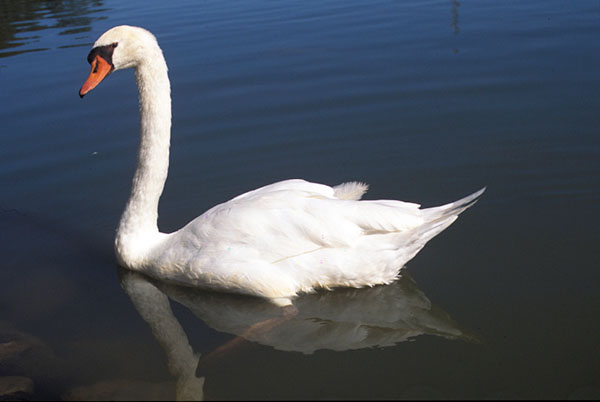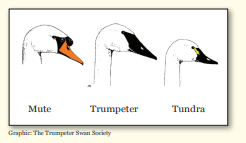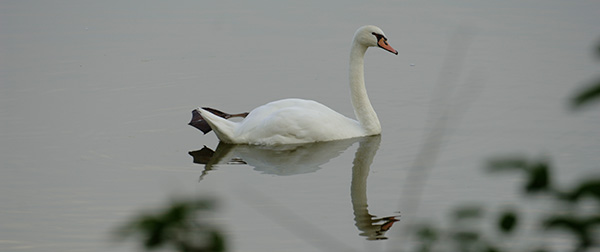
Introduction and regulations
Mute swans (Cygnus olor) are an invasive species that have become established in high numbers on many bodies of water in Indiana. They can damage our aquatic and wetland ecosystems while acting aggressively toward people, pets, and native wildlife. However, many people are unaware of the problems mute swans cause but are instead drawn to them because they are a charismatic and beautiful large bird.
The mute swan is native throughout much of Eurasia. It was introduced into the United States in the late 19th century. The species now occupies a large part of the country with the largest populations found around the Great Lakes region and the Atlantic coast.
Because mute swans are not native to the United States, federal protection for the species under the Migratory Bird Treaty Reform Act was removed in 2004. In Indiana, however, mute swans are currently regulated, and a permit from Indiana DNR is required to disturb eggs or to capture or legally take a mute swan, unless it is on property that you own or lease. Live mute swans may be kept as pets, bred in captivity, and sold without a permit from the DNR, but must be pinioned (i.e., made flightless) and kept in an enclosure that prevents their escape into the wild.
Mute Swan at a Glance
- Weight: Up to 26 pounds for males and 21 pounds for females, which ranks as the second- largest waterfowl species behind trumpeter swans.
- Wingspan: 7-8 feet.
- Lifespan: Usually less than 10 years in the wild and up to 30 years or more in captivity.
- Flight speed: 50-55 mph.
- Range: Native throughout much of Eurasia. Introduced into the United States.
- Habitats: Lakes, rivers, farm ponds, wetlands, and coastal estuaries.
- Foods: Primarily vegetation but occasionally small invertebrates and vertebrates.
Similar Species

Courtesy The Trumpeter Swan Society
There are three species of swans that can be found in Indiana. At this time, the mute swan is the most abundant swan in Indiana and can commonly be found year-round, except perhaps during the harshest winter weather. Less abundant are native trumpeter and tundra swans. Trumpeter swans are a state endangered species that have seen recent breeding success in some northern Indiana counties. Ohio had a considerable increase of trumpeter swans along Lake Erie after aggressive management and removal of mute swans. Tundra swans breed in remote Arctic areas and pass through Indiana during fall migration to their wintering grounds along the mid-Atlantic coast.
All three species have bright white plumage as adults. The easiest way to differentiate mute swans from the other two species is that adult mute swans have an orange beak with a black border near their eyes and a black knob atop their beak. Trumpeter and tundra swans have beaks that are completely black.

Mute swan impacts
As the mute swan population has greatly expanded over the last few decades, so has the destruction of habitats attributed to their presence. An adult mute swan consumes up to eight pounds of aquatic and wetland vegetation per day. In addition, they uproot significantly more vegetation than they eat, some of which can wash ashore and create an unsightly mess for shoreline residents to clean up. During nest building, they can destroy large areas of wetland vegetation. These disturbances can have a serious impact on water quality, aquatic habitat for fish and wildlife, and wetland functions. Major disturbance commonly leads to invasive species establishment. Mute swan feeding can reduce the available food sources that native waterfowl and native birds require.
Mute swans are one of the world’s most aggressive waterfowl species and injure, kill, or displace native birds and other waterfowl, such as sandhill cranes and trumpeter swans. Adult mute swans may become especially aggressive toward people and pets in areas where they have become accustomed to food handouts. During the nesting season and rearing of young (typically March-July), mute swans have been known to aggressively drive off people and pets that enter their territory and have even knocked people from their boat and drowned them.
The invasive mute swan and its destructive impacts to native ecosystems can negatively affect other swan species. A trumpeter swan reintroduction program has been ongoing for more than 20 years in Ohio’s portion of Lake Erie. Establishment of trumpeter swans was slow until Ohio implemented its Swan Management Plan, which called for the removal of mute swans from public wildlife areas. The response was a strong increase in endangered trumpeter swan numbers. Trumpeter swan numbers have increased so much that the species is no longer a threatened species in Ohio.
Mute swans, notably, are not the solution to Canada goose conflicts. While mute swans may keep Canada geese at a distance, especially during periods of nesting and rearing of young, they will not drive Canada geese away from waters. In fact, mute swans may push more Canada geese onto lawns around waters where there is already an extensive amount of conflict between the Canada geese and property owners.
